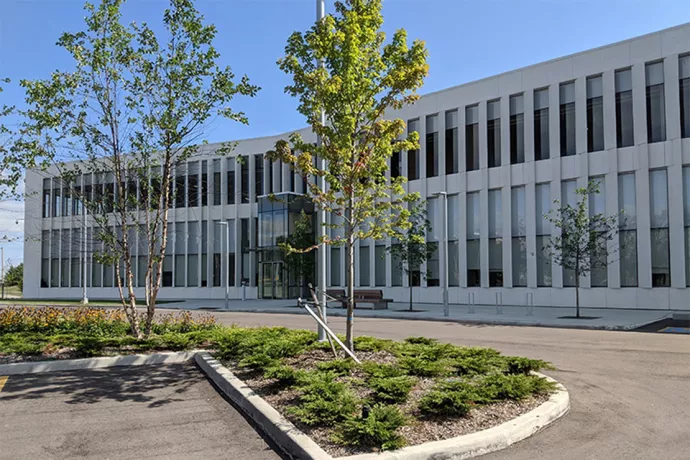
With U of T as a partner, advanced materials research facility in Mississauga to focus on clean energy
The University of Toronto will play a key role in a new National Research Council of Canada (NRC) advanced research materials facility focused on clean energy.
The new research facility, the NRC’s first in Greater Toronto, will serve as a Canadian clean energy hub that supports research into advanced materials and transitions them to industrial use. It will bring together companies, governments and universities to work on clean tech projects.
The NRC Mississauga facility will also be home to the new Collaboration Centre for Green Energy Materials (CC-GEM) – a partnership between U of T and NRC.
“Tackling the reduction of the environmental footprint of Canadians is a grand challenge that requires bold ideas and collaboration across disciplinary boundaries to solve,” Derek Newton, U of T’s assistant vice-president, innovation, partnerships and entrepreneurship, said during a virtual ribbon-cutting ceremony that took place Monday on Zoom.
“The University of Toronto looks forward to collaborating with the NRC to accelerate the work of U of T’s researchers and training students to achieve new discoveries and apply them to further reduce the environmental impact of the electricity that powers the businesses, homes and vehicles of Canadians and people around the world.”
The CC-GEM joint initiative will be co-led by: U of T Professor Dwight Seferos in the department of chemistry in the Faculty of Arts & Science; U of T Professor Timothy Bender in the Department of Chemical Engineering & Applied Chemistry in the Faculty of Applied Science & Engineering; and Michel Dumoulin, the NRC’s vice-president of engineering.
It will contribute to the green economy and address a range of research areas including more sustainable energy solutions and renewable fuels.
“Sustainably meeting our growing energy needs is one of the most critical challenges we face,” said Christopher Yip, dean of U of T’s Faculty of Applied Science & Engineering. “Professor Bender and his multidisciplinary team have a strong track record of success in transforming fundamental insights in chemistry, engineering and materials science into innovative technologies.
“This partnership will catalyze the transformation of these discoveries into innovative products and new business ventures that will power a greener Canadian economy.”

“This centre combines the world-class materials science and research capabilities of the University of Toronto and the National Research Council to accelerate the discovery of new materials that will be critical to the next generation of energy technologies,” said Melanie Woodin, dean of U of T’s Faculty of Arts & Science. “This initiative will also help train the scientists and engineers needed for Canada’s clean-tech sector. ”
CC-GEM is the second collaboration between NRC and U of T and is expected to lead to discoveries and advances that will yield publications, patents, and the commercialization of technology, as well as the creation of jobs and new industries.
Newton was one of several participants on Monday’s Zoom call. Others included: Roger Scott-Douglas, acting president of the NRC, Navdeep Bains, the federal minister of innovation, science and industry and Bonnie Crombie, mayor of Mississauga.
“The opening of our new facility in Mississauga represents a major stepping-stone for the National Research Council of Canada in advancing Canada’s clean-energy agenda,” Scott-Douglas said.
“Our vision is for this collaborative hub to become the home to new technologies that will enable industry to be more sustainable, and we look forward to working with all our partners in accelerating the development of innovations in advanced materials to support industry.”
The 21,500-square-foot facility in Mississauga’s Sheridan Park will support the development of cutting-edge technologies, including artificial intelligence-driven robotics platforms dubbed “material acceleration platforms,” otherwise known as self-driving labs. The initial focus will be developing materials that allow the conversion of carbon dioxide into fuels and other high-value industrial products, including multi-functional powder and nanomaterials, and “advanced metamaterials and devices for consumer, automotive, aerospace and biomedical applications.”
The facility will see government, companies and post-secondary institutions like U of T and the University of Waterloo working together on clean-tech projects, with the space accommodating university equipment as well as researchers and students. The facility is part of the Canadian Campus for Advanced Materials Manufacturing (CCAMM), a joint initiative between the NRC and the Xerox Research Centre of Canada, which is adjacent to NRC Mississauga.
At the launch, Bains said the government is “committed to supporting innovative partnerships that will cement Canada as a world innovation leader.”
He also announced the addition of the Materials for Clean Fuels Challenge program, a seven-year, $57-million collaborative research program that will be housed at the new facility. It will focus on the development of new materials to be used in the production of clean energy, with the aim of decarbonizing Canada's oil and gas and petrochemical sectors.
